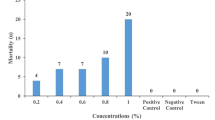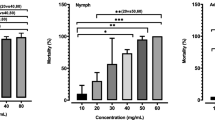Abstract
The objective of this work was to characterize and investigate the acaricidal activity of the essential oil of the aerial parts of Lippia triplinervis at different concentrations on unengorged larvae and engorged females of Rhipicephalus microplus. The essential oil yielded 2.21 % (w/w to dry matter) and was composed mainly of carvacrol (31.9 %), thymol (30.6 %), and p-cymene (12.3 %). Two tests were performed to assess the acaricidal activity: the modified larval packet test, with concentrations of 2.5, 5.0, 10.0, 15.0, and 20.0 mg/mL and the female immersion test, with concentrations of 10.0, 20.0, 30.0, 40.0, and 50.0 mg/mL. There were ten repetitions for each concentration, and for each test, a control group was formed in which the ticks were treated with Tween 80 (20 mg/mL). The experimental groups were kept in a climate-controlled chamber (27 ± 1 °C and RH >80 %). The mortality of the larvae was above 95 % in all the groups tested and reached 100 % as of the 5.0 mg/mL concentration, while the control group exhibited 0 % mortality. In the female immersion test, there was a significant decline (p < 0.05) in the egg mass weight, egg production index, and hatching percentage starting at the concentration of 30.0, 40.0, and 20.0 mg/mL, respectively, and the control percentage at the concentrations of 40.0 and 50.0 mg/mL were above 90 and 95 %. The L. triplinervis oil as thus an alternative source of the monoterpenes thymol, carvacrol, and p-cymene, and its toxicity on R. microplus larvae and females makes it promising possibility for control of this tick.


Similar content being viewed by others
References
Adams RP (2007) Identification of essential oil components by gas chromatography/mass spectrometry. Allured, Carol Stream
Amaral MAS, Rocha CMBM, Faccini JLH, Furlong J, Monteiro CMO, Prata MCA (2011) Perceptions and attitudes among milk producers in Minas Gerais regarding cattle tick biology and control. Rev Bras Parasitol Vet 20:194–201
Bennett GF (1974) Oviposition of Boophilus microplus (Canestrini, 1887) (Acarina: Ixodidae). I Influence of tick size on egg production. Acarol 16:52–61
Botelho MA, Nogueira NAP, Bastos GM, Fonseca SGC, Lemos TLG, Matos FJA, Montenegro D, Heukelbach J, Rao VS, Brito GAC (2007) Antimicrobial activity of the essential oil from Lippia sidoides, carvacrol and thymol against oral pathogens. Bras J Med Biol Res 40:349–356
Camurça-Vasconcelos ALF, Bevilaqua CML, Morais SM, Maciel MV, Costa CTC, Macedo ITF, Oliveira LMB, Braga RR, Silva RA, Vieira LS (2007) Anthelmintic activity of Croton zehntneri and Lippia sidoides essential oils. Vet Parasitol 148:288–294
Castro-Janer E, Martins JR, Mendes MC, Namindome A, Klafke GM, Schumaker TTS (2010) Diagnoses of fipronil resistance in Brazilian cattle ticks (Rhipicephalus (Boophilus) microplus) using in vitro larval bioassays. Vet Parasitol 173:300–306
Carvalho AF, Melo VM, Craveiro AA, Machado MI, Bantim MB, Rabelo EF (2003) Larvicidal activity of the essential oil from Lippia sidoides Cham. against Aedes aegypti Linn. Mem Inst Oswaldo Cruz 98:569–571
Cavalcanti SCH, Niculau EDOSS, Blank AF, Câmara CAG, Araújo IN, Alves PB (2010) Composition and acaricidal activity of Lippia sidoides essential oil against two-spotted spider mite (Tetranychus urticae Koch). Bioresource Technol 101:829–832
Cetin H, Cilek JE, Aydin L, Yanikoglu A (2009) Acaricidal effects of the essential oil of Origanum minutiflorum against Rhipicephalus turanicus. Vet Parasitol 160:359–361
Cetin H, Cilek JE, Oz E, Aydin L, Deveci O, Yanikoglu A (2010) Acaricidal activity of Satureja thymbra L. essential oil and its major components, carvacrol and γ-terpinene against adult Hyalomma marginatum (Acari: Ixodidae). Vet Parasitol 170:287–290
Chagas ACS (2004) Controle de parasitas utilizando extratos vegetais. Rev Bras Parasitol Vet 13:156–160
Clemente MA, Monteiro CMO, Scoralik MG, Gomes FT, Prata MCA, Daemon E (2010) Acaricidal activity of the essential oil from Eucalyptus citriodora and Cymbopogon nardus on larvae of Amblyomma cajennense (Acari: Ixodidae) and Anocetor nitens (Acari: Ixodidae). Parasitol Res 107:987–992
Daemon E, Monteiro CMO, Rosa LS, Clemente MA, Arcoverde A (2009) Evaluation of the acaricide activity of thymol on engorged and unengorged larvae of Rhipicephalus sanguineus (Latreille, 1808) (Acari: Ixodidae). Parasitol Res 105:495–497
Daemon E, Maturano R, Monteiro CMO, Scoralik M, Massoni T (2012a) Acaricidal activity of hydroethanolic formulations of thymol against Rhipicephalus sanguineus (Acari: Ixodidae) and Dermacentor nitens (Acari: Ixodidae) larvae. Vet Parasitol 186:542–545
Daemon E et al (2012b) Spectroscopic evaluation of thymol dissolved by different methods and influence on acaricidal activity against larvae of Rhipicephalus microplus (Acari: Ixodidae). Parasitol Res 111:1901–1906
Dolan M, Jordan RA, Schulze TL, Schulze CJ, Cornell M, Ruffolo D, Schmidt JP, Piesman J, Karchesy J (2009) Ability of two natural products, nootkatone and carvacrol, to suppress Ixodes scapularis and Amblyomma americanum (Acari: Ixodidae) in a Lyme disease endemic area of New Jersey. J Econ Entomol 102:2316–2324
Drummond RO, Ernest SE, Trevino JL, Gladney WJ, Graham OH (1973) Boophilus anulatus and Boophilus microplus: laboratory test of insecticides. J Econ Entomol 66:130–133
Ferreira P, Soares GLG, D’avila S, Bessa ECA (2009) The influence of caffeine and thymol on the survival, growth and reproduction of Subulina octona (Brugüière, 1789) (Mollusca, Subulinidae). Braz Arch Biol Technol 52:945–952
Furlong J, Martins JR, Prata MCA (2007) O carrapato dos bovinos e a resistência: temos o que comemorar? A Hora Vet 27:1–7
Gazim ZC, Demarchi IG, Lonardoni MVC, Amorim ACL, Hovell AMC, Rezende CM, Ferreira GA, Lima EL, Cosmo FA, Cortez DAG (2011) Acaricidal activity of the essential oil from Tetradenia riparia (Lamiaceae) on the cattle tick Rhipicephalus (Boophilus) microplus (Acari: Ixodidae). Exp Parasitol 129:175–178
Grisi L, Massard CL, Moya-Borja GE, Pereira JB (2002) Impacto econômico das principais ectoparasitoses em bovinos no Brasil. A Hora Vet 21(125):8–10
Gomes GA, Monteiro CMO, Senra TOS, Zeringota V, Calmon F, Matos RS, Gois RWS, Daemon E, Santiago GMP, Carvalho GM (2012) Chemical composition and acaricidal activity of essential oil from Lippia sidoides (Verbenaceae) on larvae of Rhipicephalus microplus (Acari: Ixodidae) and larvae and engorged females of Dermacentor nitens (Acari: Ixodidae). Parasitol Res 111(6):2423–2430
Goskun S, Girisgin O, Kürkcüoglu M, Malyer H, Girisgin AO, Kirimer N, Baser KH (2008) Acaricidal efficacy of Origanum onites L. essential oil against Rhipicephalus turanicus (Ixodidae). Parasitol Res 103:259–261
Imdorf A, Kilchenman V, Bogdanov S (1995) Toxiziät von thymol; campher, menthol and eucaliptol auf Varroa jacobsoni oud Ind Apis mellifera L. in labortest. Apidologie 26:27–31
Klafke GM (2008) Resistência de Rhipicephalus (Boophilus) microplus aos carrapaticidas. In: Pereira MC, Labruna MB, Szabo MPJ, Klafke GM (eds) Rhipicephalus (Boophilus) microplus: Biologia. Controle e Resistência. MEDVET, São Paulo, pp 65–80
Lacoste E, Chaumont JP, Mandin D, Plumel MM, Matos FJ (1996) Antiseptic properties of essential oil of Lippia sidoides Cham. Application to the cutaneous microflora. Ann Pharm Fr 54:228–230
Lambert RJW, Skandamis PN, Coote P, Nychas GJE (2001) A study of the minimum inhibitory concentration and mode of action of oregano essential oil, thymol and carvacrol. J Appl Microbiol 91:453–462
Leitão SG, Damasceno JPL, Martini MG, Miranda SN, Neufeld PM, Salimena FR, Bizzo HR (2011) Analysis of the chemical composition and antimicrobial activity of the essential oil from Lippia triplinervis Gardner (Verbenaceae). J Essent Oil Res 23:20–24
Lemos TLG, Monte FJQ, Matos FJA, Alencar JW, Craveiro AA, Barbosa RCSB, Lima EO (1992) Chemical composition and antimicrobial activity of essential oils from Brazilian plants. Fitoterapia 63:266–268
Lima RK, Cardoso MG, Moraes JC, Carvalho SM, Rodrigues VG, Guimaraes LGL (2011) Chemical composition and fumigant effect of essential oil of Lippia sidoides Cham. and monoterpenes against Tenebrio molitor (L.) (Coleoptera: Tenebrionidae). Ciênc Agrotec 35:664–671
Maciel MDOV et al (2009) Atividade inseticida dos óleos essenciais de Lippia sidoides e Coriandrum sativum sobre Lutzomyia longipalpis. Ciênc Animal 19:77–87
Martinez-Velazques M, Rosario-Cruz R, Castillo-Herrera G, Flores-Fernandez JM, Alvarez AH, Lugo-Cervantes E (2011) Acaricidal effect of essential oils from Lippia graveolens (Lamiales: Lamiaceae), Rosmarinus officinalis (Lamiales: Lamiaceae), and Allium sativum (Liliales: Liliaceae) against Rhipicephalus (Boophilus) microplus (Acari: Ixodidae). J Med Entomol 48:822–827
Martins JRS, Furlong J, Leite RC (2006) In: Barros-Battesti DM, Arzua M, Bechara GH (eds) Controle de carrapatos. Carrapatos de importância médico veterinária da região neotropical: um guia ilustrado para identificação de espécies. Vox/ICTTD-3/Butantan, São Paulo, pp 145–153
Mendes AS, Daemon E, Monteiro CMO, Maturano R, Brito FC, Massoni T (2011) Acaricidal activity of thymol on larvae and nymphs of Amblyomma cajennense (Acari: Ixodidae). Vet Parasitol 183:136–139
Monteiro CMO, Daemon E, Clemente MA, Rosa LS, Maturano R (2009) Acaricidal efficacy of thymol on engorged nymphs and females of Rhipicephalus sanguineus (Latreille, 1806) (Acari: Ixodidae). Parasitol Res 105:1093–1097
Monteiro CMO, Daemon E, Silva AMR, Maturano R, Amaral C (2010) Acaricide and ovicide activities of thymol on engorged females and eggs of Rhipicephalus (Boophilus) microplus (Acari: Ixodidae). Parasitol Res 106:615–619
Monteiro CMO et al (2012) Acaricidal activity of eugenol on Rhipicephalus microplus (Acari: Ixodidae) and Dermacentor nitens (Acari: Ixodidae) larvae. Parasitol Res 111:1295–1300
Nostro A, Roccaro AS, Bisignano G, Marino A, Cannatelli A, Pizzimenti FC, Cioni PL, Procopio F, Blanco AR (2007) Effects of oregano, carvacrol and thymol on Staphylococcus aureus and Staphylococcus epidermidis biofilms. J Med Microbiol 56:519–523
Ntalli NG, Ferrari F, Giannakou I, Menkissoglu-Spiroudi U (2011) Synergistic and antagonistic interactions of terpenes against Meloidogyne incognita and the nematicidal activity of essential oils from seven plants indigenous to Greece. Pest Manag Sci 67:341–351
Pascual ME, Slowing K, Carretero E, Sánchez Mata D, Villar A (2001) Lippia: traditional uses, chemistry and pharmacology: a review. J Ethnopharmacol 76:201–214
Paster N, Menasherov M, Ravid U, Juven B (1995) Antifungal activity of oregano and thyme essential oils applied as fumigants against fungi attacking stored grain. J Food Prot 58:81–85
Pirali-Kheirabadi K, Silva JAT (2010) Lavandula augustifolia essential oil as a novel and promising natural candidate for tick (Rhipicephalus (Boophilus) annulatus) control. Exp Parasitol 126:184–186
Ribeiro VLS, Santos JC, Bordignon SAL, Apel MA, Henriques AT, Poser GL (2010) Acaricidal properties of the essential oil from Hesperozygis ringens (Lamiaceae) on the cattle tick Rhipicephalus (Boophilus) microplus. Bioresource Technol 101:2506–2509
Rodriguez MLA, Massard CL, Fonseca AH, Ramos NF, Machado H, De La Fuente JL (1995) Effect of vaccination with a recombinant Bm86 antigen preparation on natural infestation of Boophilus microplus in grazing dairy cattle in Brazil. Vaccine 13(18):1804–1808
Samish M, Glazer I (2001) Entomopathogenic nematodes for the biocontrol of ticks. Trends Parasitol 17(8):368–371
Salimena FRG (2010) Uma nova espécie de Lippia L. (Verbenaceae) do cerrado brasileiro. Acta Bot Bras 24:232–234
Sarrazin SLF, Oliveira RB, Barata LES, Mourão RHV (2012) Chemical composition and antimicrobial activity of the essential oil of Lippia grandis Schauer (Verbenaceae) from the western Amazon. Food Chem 134:1474–1478
Scoralik MG, Daemon E, Monteiro CMO, Maturano R (2012) Enhancing the acaricide effect of thymol on larvae of the cattle tick Rhipicephalus microplus (Acari: Ixodidae) by solubilization in ethanol. Parasitol Res 110:645–648
Stone BF, Haydock KP (1962) A method for measuring the acaricide susceptibility of the cattle B. microplus (Can.). Bull Entomol Res 53:563–578
Tasdemir D, Kaiser M, Demirci F, Baser KHC (2006) Essential oil of Turkish Origanum onites L. and its main components, carvacrol and thymol show potent antiprotozoal activity without cytotoxicity. Planta Med 72:1006
Terblanché FC, Kornelius G (1996) Essential oil constituents of the genus Lippia (Verbenaceae)—a literature review. J Essent Oil Res 8:471–485
Veras HNH, Rodrigues FFG, Colares AV, Menezes IRA, Coutinho HDM, Botelho MA, Costa JGM (2012) Synergistic antibiotic activity of volatile compounds from the essential oil of Lippia sidoides and thymol. Fitoterapia 83:508–512
Author information
Authors and Affiliations
Corresponding authors
Rights and permissions
About this article
Cite this article
Lage, T.C.A., Montanari, R.M., Fernandes, S.A. et al. Activity of essential oil of Lippia triplinervis Gardner (Verbenaceae) on Rhipicephalus microplus (Acari: Ixodidae). Parasitol Res 112, 863–869 (2013). https://doi.org/10.1007/s00436-012-3209-y
Received:
Accepted:
Published:
Issue Date:
DOI: https://doi.org/10.1007/s00436-012-3209-y




